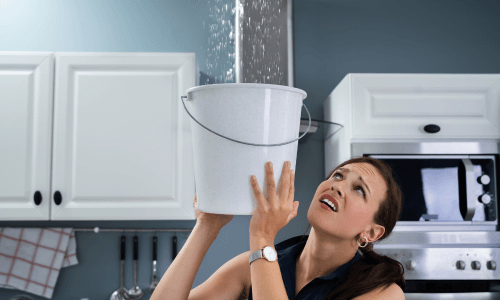
What To Do When Water Is Leaking From Your Ceiling
When water leaking from ceiling, it’s important to take immediate action to prevent further damage to your home and address the underlying cause of the leak. Here’s how a local plumber might advise you to handle this situation:A. Identify the Source of the Leak:
When water leaking from ceiling, quickly identifying the source is crucial. Start by locating the exact spot where water is dripping or pooling on the ceiling. Trace the path of the water back to its highest point, typically directly above the leak. Check plumbing fixtures above the affected area for signs of leaks or drips, including sinks, toilets, showers, and pipes. If accessible, inspect the attic or crawl space above the ceiling for signs of water intrusion, such as wet insulation or water stains on rafters or joists.
Additionally, examine the roof for missing shingles, damaged flashing, or deteriorated sealant around roof penetrations. Document your findings with photos or videos for reference. If you’re unable to locate the source of the leak or if the problem persists, contact a professional plumber or roofing contractor for further inspection and repair. Prompt action can help prevent further damage to your home.
B. Turn Off the Water Supply:
When water leaking from ceiling, one of the first steps you should take is to turn off the water supply to the affected area. Locate the main shut-off valve for the water source causing the leak, typically found near the fixture or appliance that’s leaking, or at the main water shut-off valve for your home. Turn the valve clockwise to shut off the water flow and stop the leak. This prevents further water damage while you address the issue.
If you’re unable to identify or access the shut-off valve, consider shutting off the main water supply to your home until the leak can be resolved. Turning off the water supply also ensures the safety of your home’s occupants and minimizes the risk of electrical hazards from water exposure. Once the leak is repaired, you can safely restore water flow by turning the shut-off valve counter clockwise. If you’re unsure how to locate or operate the shut-off valve, contact a professional plumber for assistance.
C. Contain the Water: Ceiling Water Leak Repair
Containing the water when a ceiling leak occurs is essential to prevent further damage to your home and belongings. Start by placing buckets, pots, or towels beneath the leak to catch dripping water and minimize spreading to other areas. If the leak is substantial, use a tarp or plastic sheeting to redirect water away from electrical outlets, furniture, and valuables. Additionally, consider using a wet/dry vacuum to remove standing water from the floor to prevent it from seeping into carpets or causing structural damage. It’s crucial to act quickly to contain the water and prevent it from causing additional harm, such as mold growth or electrical hazards. Once the leak is contained, focus on addressing the source of the leak and repairing any damage to the ceiling or surrounding areas. If you’re unable to contain the water effectively or if the leak continues to worsen, seek assistance from a professional plumber or restoration company to mitigate the damage and ensure your home’s safety.
D. Assess the Severity of the Leak:
Assessing the severity of a ceiling leak is crucial for determining the appropriate course of action. Start by evaluating the extent of the water damage, including the size of the affected area, the rate of water flow, and any visible signs of structural damage or mold growth. Determine whether the leak is a minor drip or a more serious, continuous flow of water. Assess the potential risks posed by the leak, such as electrical hazards from water exposure or structural damage to the ceiling or surrounding areas.
Consider the impact on your home’s occupants, including safety concerns and the need for temporary accommodations if the leak affects livable areas. Once you’ve assessed the severity of the leak, prioritize addressing any immediate threats to safety or property damage. If the leak is minor and easily manageable, you may be able to address it yourself. However, if the leak is severe or poses significant risks, such as extensive water damage or structural instability, it’s advisable to seek professional assistance from a plumber or restoration company to address the issue promptly and effectively.
E. Address Plumbing Issues: Restoration Service Tampa
Addressing plumbing issues promptly is essential when water leaking from ceiling to prevent further damage and restore the integrity of your home’s plumbing system. Start by identifying the source of the leak, which may involve inspecting pipes, fixtures, or appliances located above the affected area. Common plumbing issues that can cause ceiling leaks include burst pipes, leaking joints, worn-out seals, or faulty appliances.
Once the source of the leak is identified, take appropriate steps to address the plumbing issue. This may involve repairing or replacing damaged pipes, tightening loose fittings, or replacing worn-out seals or gaskets. Depending on the severity of the issue, you may be able to resolve the problem yourself using basic plumbing tools and materials. However, if the leak is extensive or requires specialized knowledge and equipment, it’s advisable to seek assistance from a professional plumber.
A qualified plumber like our experts at local Plumber, can accurately diagnose the issue, recommend the most effective solution, and perform repairs safely and efficiently to restore your home’s plumbing system to proper working order.
F. Dry Out the Affected Area:
Drying out the affected area is crucial after water has leaked from your ceiling to prevent further damage and minimize the risk of mold growth and structural deterioration. Start by removing any standing water using towels, mops, or a wet/dry vacuum cleaner. Open windows and doors to promote air circulation and ventilation, which helps accelerate the drying process.
Use fans or dehumidifiers to remove excess moisture from the air and surfaces, focusing on the affected area and surrounding spaces. If possible, remove any wet or damp materials, such as carpeting, insulation, or furniture, to allow them to dry separately. Monitor the affected area regularly for signs of moisture or mold growth, and continue drying until all surfaces are completely dry to the touch. Be patient, as thorough drying may take several days or even weeks, depending on the extent of the water damage and environmental conditions.
Once the affected area is fully dried out, you can proceed with repairing any damage to the ceiling, walls, or flooring to restore your home to its pre-leak condition. If you’re unable to dry out the affected area effectively or if mold growth persists, consider seeking assistance from a professional restoration company to mitigate the damage and ensure your home’s safety.
G. Repair and Restore: 24 Hour Emergency Service
Repairing and restoring the damaged areas after a ceiling leak is crucial to ensure the structural integrity and aesthetics of your home. Start by assessing the extent of the damage, including any water stains, discoloration, or structural issues caused by the leak. Repair any damaged drywall, plaster, or ceiling tiles by patching or replacing them as needed.
Sand down any rough edges and apply primer and paint to match the surrounding area, restoring the appearance of the ceiling. Inspect flooring, insulation, and any other affected materials for signs of damage, such as warping or mold growth, and repair or replace them as necessary. Address any underlying plumbing issues that caused the leak to prevent future problems.
Additionally, consider taking preventative measures, such as reinforcing ceiling supports or improving ventilation, to minimize the risk of future leaks. Finally, document the repairs and keep records of any expenses incurred for insurance purposes. By promptly repairing and restoring the damaged areas, you can prevent further damage to your home and ensure a safe and comfortable living environment for you and your family.
H. Prevent Future Leaks: Leak detection 24/7 Service
Take steps to prevent future leaks by maintaining your plumbing system regularly. Schedule routine inspections and maintenance with a professional plumber to identify and address potential issues before they escalate into major leaks.
Regular Maintenance:
Schedule regular inspections of your plumbing system, including pipes, fixtures, and appliances, to check for any signs of wear, corrosion, or leaks. Address any issues promptly to prevent them from escalating into larger problems.Proper Installation:
Ensure that plumbing fixtures and appliances are installed correctly by a qualified professional to prevent leaks from loose connections or faulty installation.Sealants and Caulking:
Inspect and replace worn-out sealants and caulking around sinks, showers, bathtubs, and other areas where water can seep through gaps or cracks.Roof Maintenance:
Regularly inspect your roof for missing or damaged shingles, cracked flashing, or deteriorated sealant around roof penetrations. Repair any issues promptly to prevent water from entering your home.Insulation:
Ensure that pipes are properly insulated, especially in areas prone to freezing temperatures, to prevent them from bursting and causing leaks.Gutters and Downspouts:
Keep gutters and downspouts clear of debris to prevent water from accumulating on your roof and seeping into your home’s interior.Monitor Water Usage:
Be mindful of your water usage habits and avoid overloading drains or fixtures with excessive water flow.I. Contact Your Insurance Provider:
Contacting your insurance provider promptly is crucial when dealing with a ceiling leak. Inform them of the situation and provide details of the damage. Review your policy to understand your coverage and file a claim if applicable. Document the damage with photos or videos for evidence. Your insurance provider can guide you through the claims process and recommend approved contractors for repairs. Taking these steps promptly can help expedite the resolution and ensure you receive the necessary support to restore your home.By following these steps and seeking assistance from a professional plumber when needed, you can effectively address a water leaking from ceiling and prevent further damage to your home. Swift action is key to minimizing the impact of the leak and restoring your home to a safe and comfortable condition. For residents of Sarasota, Clearwater, Tampa, and Saint Petersburg, contacting us at local plumber ensures prompt and reliable service tailored to the specific needs of the area.
Get in touch with us today for a quote and let us handle all your plumbing needs. Email us at services@local-plumber.com or call us at 813-776-7667 (POOP).





Leave a comment